Stefan's Tesla-Pages
My second solid state TC (DC output)
again using a fly-back transformer
![[home]](buthome.jpg)

Table of contents:
-
Specs of the fly-back circuit
-
Photos
Mini-Lifter
Other Experiments
The specs of the second TV fly-back
system are:
-
Control board
-
Not required, just a switch.
-
-
Circuit
-
This circuit was designed and buildt for me by a coiling friend from France.
The purpose of this circuit is to reach higher voltages than possible with
neons (only 8kV in germany) for some experiments with my TCs in single shot
mode (very low BPS with big caps). I buildt the 42VDC power supply (with
additional 21V mode) and tried to add some minor changes in the grounding
system - and promtly killed the FET... Standard output voltage is 23.7kV
(measured with 1 GOhm HV-probe on VOM). With only 21V input voltage, the
output is 12.7kV. The flyback should deliver about 3mA (according to Peter
who buildt it), but the input power is only 10W. Assuming an efficiency of
75% (guess it is more like 50%), there are only 7.5W at the output side,
the high voltage dropping down to perhaps 15kV at only 0.5mA load.
< circuit diagram and more information coming soon >
![[under construction]](baustel.gif)
-
Experiments / max. arcs
-
17mm quiet arc at 24kVDC output
-
I've driven my 2"-TC for some experiments with variable BPS. The diagram
can be found in the efficiency section of my
technological background page.
-
An other experiment I did was the standard plasma globe with different bulb
sizes. But - nothing happens. Not with the smallest bulb! After some minutes
of thinking, the solution came to my mind: this HV supply deliveres DC! And
the light bulb acts like any cap to DC: once it is charged, there is no current
(read sparks) any more..
So if you plan to build a plasma globe supply, don't make the mistake to
take a flyback with integrated diode.
-
Drive the big pin wheel with DC (here you
can see how it looks when driven with a 2.6kVA-TC). It is a good idea to
touch a ground rod when standing near this experiment. If not you'll get
a nasty zap when you touch anything earthed the next time.
Photos:
Sorry, no photos of the circuit up to now!
![[under construction]](baustel.gif)
Mini-Lifter:
A Lifter is a very low weight structure which can fly if enogh ion wind is
produced. It has NOTHING to do with antigravity and such things, as it will
not lift in vacuum
(http://www.blazelabs.com/l-vacuum.asp).
Daniel C. and I buildt two lifters (13.03.2005) but the output ftrom this
DC-supply (approx. 0.5mA at 15kVDC under load) was much to weak to get the
lifter up into the air. I let the one I buildt successfully hover with
my 40kV Cockroft-Walton multiplier at the
GTL-Teslathon2006.
Since smaller Lifters need less power, I buildt a smaller Lifter, which can
hover up into the air, lifted up by the power of this high DC voltage. During
lift-off, it is very unstable (though it has enough thrust), so I can't make
the feedlines much longer. Perhaps a tail like the one used on kites will
help here. Have to think if an isolating tail would be better than a conducting
tail connected to the aluminum foil...
![[under construction]](baustel.gif)
Design data:
side length |
10cm |
height of aluminum sheet |
__cm
![[under construction]](baustel.gif) |
diameter of corona wire |
__mm
![[under construction]](baustel.gif) |
distance of corona wire above aluminum sheet |
__cm
![[under construction]](baustel.gif) |
| weight |
__g
![[under construction]](baustel.gif) |
Since the two fine wires which deliver the voltage to the Lifter will attract
when they are to near together, a simple solution is to make a support and
provide one of the feed wires from above:

This is the first image of the first flight:
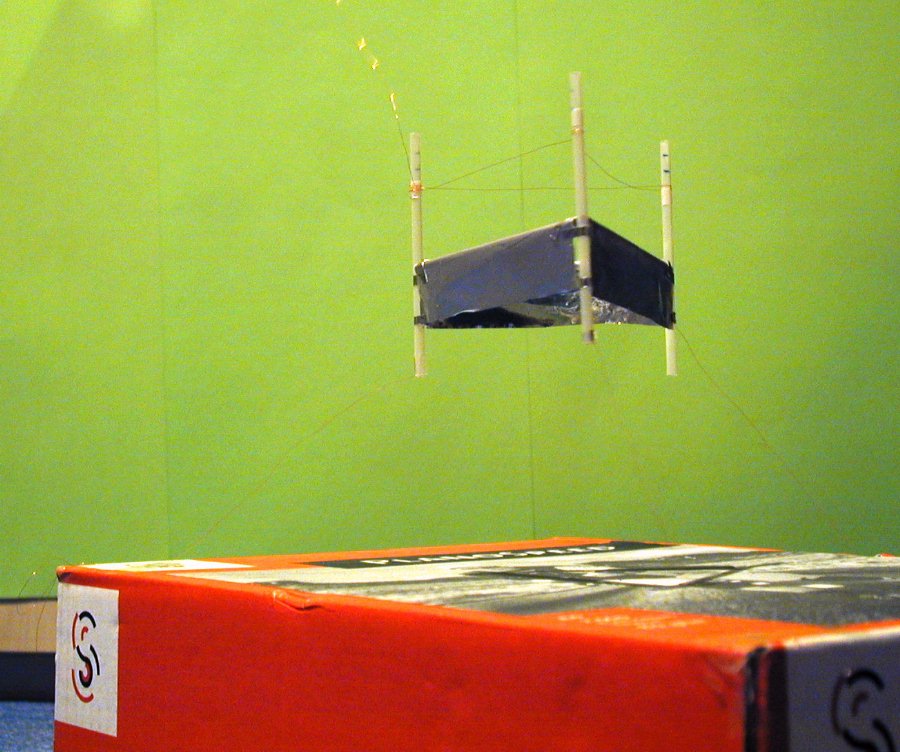
More images from the flights at the GTL-Teslathon2005 in Schwieberdingen:

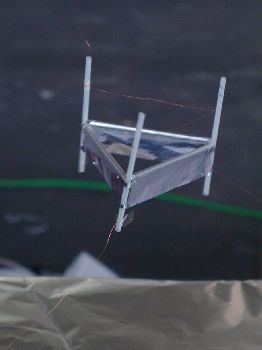
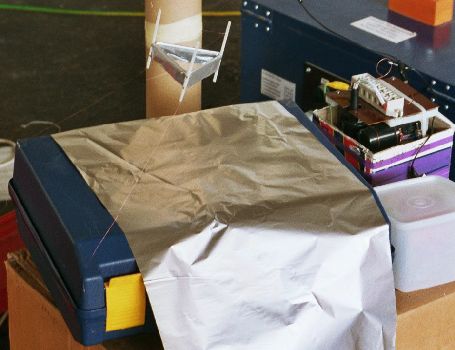
Other
Experiments:
That circuit is really hair-raising (me standing on and isolated table connected
to this HVDC source at the GTL-Teslathon2005):

With the circuit, we let some charged soap bubbles float over a charged aluminum
area (the bubbles avoided to land on the alumnium):
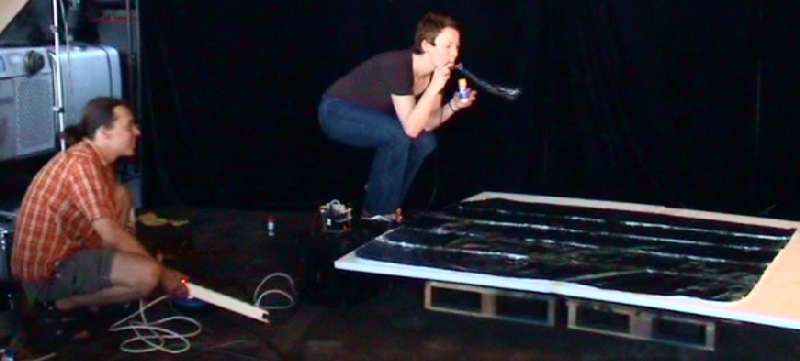
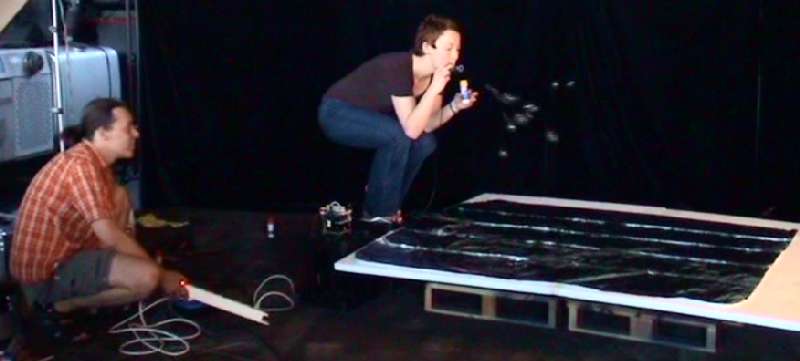
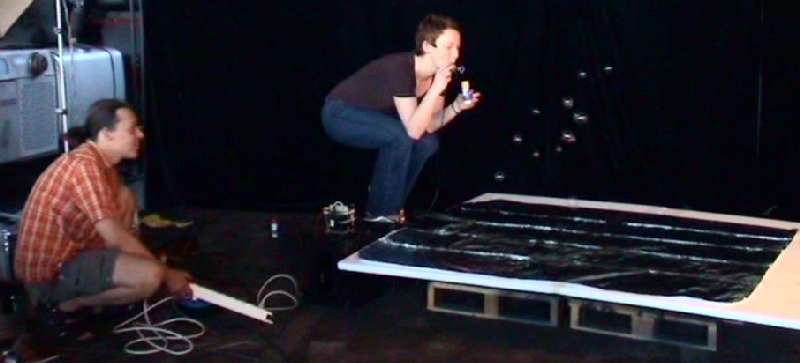

They really jumped up and down when I switched the voltage on and off!
A videoclip can be found here:
http://www.zeit-wissen.de/media/2005/04/teslathon_seifenblase.mp4
This soap bubble experiment was brought to the GTL's Teslathon2005 by the
nice people of the german popular science magazin "ZeitWissen", who made
a documentation of us which can be found here:
http://www.zeit.de/zeit-wissen/2005/04/Experiment_Strom.xml
(only in german)

![[home]](buthome.jpg)











